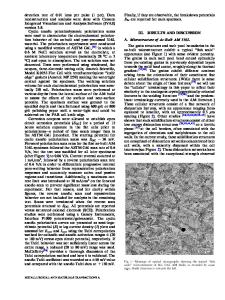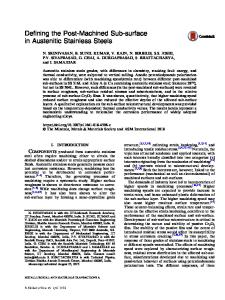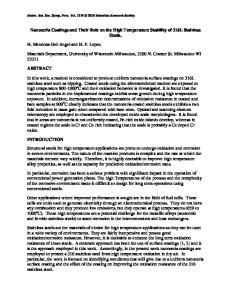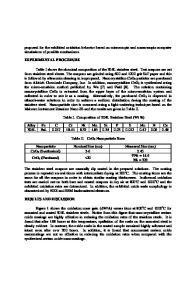On the Thermal Stability of Dislocation Cellular Structures in Additively Manufactured Austenitic Stainless Steels: Role
- PDF / 10,296,445 Bytes
- 12 Pages / 593.972 x 792 pts Page_size
- 109 Downloads / 403 Views
https://doi.org/10.1007/s11837-020-04427-7 Ó 2020 The Minerals, Metals & Materials Society
ADDITIVE MANUFACTURING FOR ENERGY APPLICATIONS
On the Thermal Stability of Dislocation Cellular Structures in Additively Manufactured Austenitic Stainless Steels: Roles of Heavy Element Segregation and Stacking Fault Energy PU DENG,1 HOUSHANG YIN,1 MIAO SONG,2 DIAN LI,3 YUFENG ZHENG,3 BARTON C. PROROK,1 and XIAOYUAN LOU
1,4
1.—Department of Mechanical Engineering, Materials Research and Education Center, Auburn University, Auburn, AL 36849, USA. 2.—Nuclear Engineering and Radiological Sciences, University of Michigan, Ann Arbor, MI 48109, USA. 3.—Department of Chemical and Materials Engineering, University of Nevada Reno, Reno, NV 89557, USA. 4.—e-mail: [email protected]
The thermal stability of dislocation cellular structures in three additively manufactured (AM) austenitic stainless steels (SSs), 316L SS, 304L SS, and Al modified 316L SS (316L(Al)), were studied. Minor alloying elements, Mo and Al, were found affecting the stability of the cellular structures in AM austenitic SS, resulting in a stability ranking of AM 316L SS > AM 304L SS > AM 316L(Al) SS. As a result, their abilities towards recrystallization also differed. Owing to the high stacking fault energy (SFE) due to Al addition, AM 316L(Al) SS had the least stable subgrain cellular structure and exhibited the lowest recovery temperature. Although 316L SS possessed slightly higher SFE than 304L SS, the pinning effect due to Mo segregation at the cellular walls in AM 316L SS significantly enhanced its thermal stability. While the low-SFE AM 316L SS and AM 304L SS recovered their cellular structures via the equiaxed cell growth, the dislocation cellular walls in high-SFE AM 316L(Al) SS continuously vanished along a preferred direction. The fast recovery of cellular structures led to recrystallization retardation. The Hall–Petch model was found incapable of correlating cell size to strength because of the continuous weakening of cellular walls during heat treatment.
INTRODUCTION Laser powder bed fusion (LPBF) additive manufacturing (AM) has been widely explored as one of the most promising techniques for industries because of its exceptionally high design freedom.1 Among many distinctive microstructural features in AM stainless steel made by LPBF, the dislocation cellular structure formed during rapid laser solidification was found, enabling superior mechanical properties compared to its conventional counterparts.2 The dislocation cellular structures consist of high-density cellular walls/boundaries formed by tangled dislocations and dislocation-free interiors, with the average cellular size from 500 nm to
(Received July 20, 2020; accepted September 29, 2020)
1000 nm depending on the laser processing parameters.3,4 The partitioning of heavy solute elements on the cellular boundaries, such as Cr and Mo segregation in AM 316L SS2,5 and Cr and Ni segregation in AM 304L SS,6–8 was commonly reported. At room temperature, the dislocation cellular structure has dem
Data Loading...











